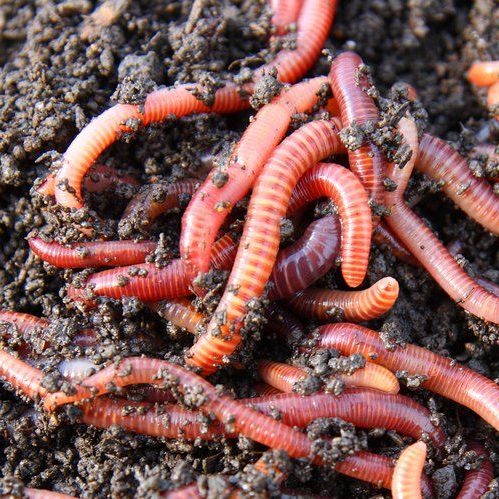Lake Hickory Bait: Reliable Supplies for Every Type of Fishing
Lake Hickory Bait: Reliable Supplies for Every Type of Fishing
Blog Article
Red Wigglers 101: Everything You Need to Know for Thriving Gardens
Red wigglers, or Eisenia fetida, play an essential duty in lasting horticulture practices, serving as efficient decomposers that transform organic waste right into useful vermicompost. Recognizing their habitat, dietary preferences, and the myriad advantages they supply can transform your gardening approach.
Recognizing Red Wigglers

Red wigglers prosper in environments rich in organic product and moisture. Red Wiggler Express. They possess a special digestive system that allows them to process food scraps quickly, excreting spreadings that are loaded with vital nutrients such as nitrogen, phosphorus, and potassium. These spreadings enhance dirt framework, boost water retention, and foster advantageous microbial activity, every one of which add to durable plant health and wellness
In addition, red wigglers can endure in diverse problems, making them adaptable to various horticulture techniques, including interior and outside composting systems. Their capability to eat huge quantities of organic waste everyday positions them as valuable allies for both home gardeners and commercial cultivators. By including red wigglers right into gardening efforts, one can significantly improve soil fertility and support lasting horticulture practices.
Ideal Environment for Red Wigglers
Developing an optimum environment for red wigglers is essential for optimizing their composting capacities and general health and wellness. Red wigglers grow in wet, dark, and well-aerated environments, which carefully resemble their all-natural atmospheres in leaf litter and decaying raw material. A suitable environment ought to offer a temperature variety between 55 ° F and 77 ° F(13 ° C to 25 ° C), as extreme temperatures can stress or damage the worms.
The bed linens product, such as shredded newspaper, cardboard, or coconut coir, should be maintained damp yet not overly damp, as excessive moisture can lead to anaerobic problems damaging to worm wellness. Furthermore, a pH degree in between 6.0 and 7.5 is optimal, ensuring a balanced environment.
Proper aeration is similarly important; it permits oxygen flow and prevents the build-up of damaging gases. A container or container developed for vermicomposting must have drain holes to get rid of excess moisture and advertise air movement. Normal monitoring of these problems is vital for keeping a thriving red wiggler population, ultimately improving their effectiveness in breaking down organic waste and enhancing yard soil.
Dietary Requirements and Preferences

Red wigglers display certain preferences; they are specifically fond of softer, decomposing products over more difficult or even more fibrous materials. It is important to stay clear of feeding them helpful resources citrus peels, onion, and garlic in huge quantities, as these can be hazardous. Additionally, meat, dairy, and oily foods should be left out, as they can draw in bugs and create unpleasant smells.
(Red Wiggler Express)Green products, such as vegetable scraps, offer nitrogen, while brownish materials, like cardboard and dried leaves, supply carbon. By providing to their dietary requirements, gardeners can promote a growing populace of red wigglers in their compost systems.
Benefits of Utilizing Red Wigglers
The impressive advantages of utilizing red wigglers in gardening extend far past their role in composting. These flexible organisms contribute significantly to soil health and wellness, enhancing nutrition availability and advertising microbial activity. By aerating the soil as they delve, red wigglers boost water drainage and root penetration, producing an optimum setting for plant development.
Furthermore, red wigglers are efficient recyclers of organic waste, converting it into nutrient-rich spreadings that work as an exceptional all-natural fertilizer. These castings have beneficial microorganisms and important nutrients, such as nitrogen, phosphorus, and potassium, which are important for plant development. The slow-moving launch of nutrients from worm castings ensures a stable supply, reducing the risk of nutrient leaching and advertising sustainable gardening practices.
Additionally, the presence of red wigglers can help subdue soil-borne plant diseases. Their digestive processes generate substances that prevent harmful microorganisms, thereby improving plant wellness. Utilizing red wigglers fosters a more lasting gardening technique by decreasing dependence on chemical plant foods and promoting a closed-loop system, where waste is changed right into beneficial resources. Generally, integrating red wigglers right into horticulture techniques offers a wide range of environmental and farming benefits.
(Lake Rhodhiss Bait)
Composting With Red Wigglers

To start a successful vermicomposting system, pick an ideal container with appropriate ventilation and drainage. The perfect environment for red wigglers includes a wet, dark setup with temperature levels between 55 ° F and 77 ° F. Begin by layering shredded paper, cardboard, and food scraps, making certain a balanced mix of carbon and nitrogen-rich products.
Red wigglers thrive on vegetable peels, fruit scraps, coffee premises, and eggshells, while avoiding meat, milk, and oily foods that can attract bugs. Frequently keep track of dampness levels; the bedding needs to perspire yet not soggy. Harvest worm castings every couple of months by separating the worms from the garden compost, which can then be made use of directly in yards or kept for later use.
Carrying out vermicomposting not just lowers garbage dump waste but likewise enriches garden dirt, promoting healthy plant growth and lasting gardening practices. Accept this environment-friendly technique to enhance your gardening undertakings.
Conclusion
In recap, red wigglers are essential microorganisms for enhancing garden performance with reliable composting. Their particular environment needs, dietary preferences, and significant advantages add to lasting horticulture techniques. By utilizing red wigglers, gardeners can considerably boost soil high quality and nutrient availability, fostering healthier plant growth. Accepting the practice of vermicomposting not only sustains waste decrease however likewise promotes an environmental equilibrium within yard ecosystems, inevitably bring about growing and resistant yards.
Report this page